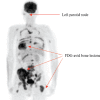Metastasis occurring eleven years after diagnosis of human papilloma virus-related oropharyngeal squamous cell carcinoma
- PMID: 25435908
- PMCID: PMC4239125
- DOI: 10.3332/ecancer.2014.480
Metastasis occurring eleven years after diagnosis of human papilloma virus-related oropharyngeal squamous cell carcinoma
Abstract
Human papilloma virus (HPV)-related oropharyngeal squamous cell carcinoma (OPSCC) is associated with a favourable prognosis, although approximately 20-25% of patients ultimately develop recurrent cancer. Most disease recurrence events appear within 3 years; however, long-term follow-up of reported studies are limited, and the risk of late recurrence is unknown. We present a case report of a patient who developed distant metastases of HPV-related SCC 11 years after initial diagnosis and treatment of HPV-related OPSCC. Late disease recurrence may occur after initial diagnosis of HPV-related OPSCC. This observation has implications on the appropriate duration of follow-up and surveillance of these patients.
Keywords: human papilloma virus; oropharynx; p16.
Figures



Similar articles
-
Management of Recurrent and Metastatic HPV-Positive Oropharyngeal Squamous Cell Carcinoma after Transoral Robotic Surgery.Otolaryngol Head Neck Surg. 2017 Jul;157(1):69-76. doi: 10.1177/0194599817696304. Epub 2017 Apr 4. Otolaryngol Head Neck Surg. 2017. PMID: 28374634
-
Effect of human papillomavirus on patterns of distant metastatic failure in oropharyngeal squamous cell carcinoma treated with chemoradiotherapy.JAMA Otolaryngol Head Neck Surg. 2015 May 1;141(5):457-62. doi: 10.1001/jamaoto.2015.136. JAMA Otolaryngol Head Neck Surg. 2015. PMID: 25742025
-
Developing a new diagnostic algorithm for human papilloma virus associated oropharyngeal carcinoma: an investigation of HPV DNA assays.J Otolaryngol Head Neck Surg. 2017 Feb 13;46(1):11. doi: 10.1186/s40463-017-0189-z. J Otolaryngol Head Neck Surg. 2017. PMID: 28193254 Free PMC article.
-
PET/CT imaging and human papilloma virus-positive oropharyngeal squamous cell cancer: evolving clinical imaging paradigm.J Nucl Med. 2014 Mar;55(3):431-8. doi: 10.2967/jnumed.113.125542. Epub 2014 Jan 9. J Nucl Med. 2014. PMID: 24408893 Review.
-
The Role of Surgery in the Management of Recurrent Oropharyngeal Cancer.Recent Results Cancer Res. 2017;206:197-205. doi: 10.1007/978-3-319-43580-0_15. Recent Results Cancer Res. 2017. PMID: 27699540 Review.
Cited by
-
Orbital mass as first presentation of metastatic p16-positive oropharyngeal squamous cell carcinoma.Curr Oncol. 2017 Dec;24(6):e551-e554. doi: 10.3747/co.24.3523. Epub 2017 Dec 20. Curr Oncol. 2017. PMID: 29270066 Free PMC article.
-
The Human Bone Marrow Is Host to the DNAs of Several Viruses.Front Cell Infect Microbiol. 2021 Apr 22;11:657245. doi: 10.3389/fcimb.2021.657245. eCollection 2021. Front Cell Infect Microbiol. 2021. PMID: 33968803 Free PMC article.
-
Cavernous sinus involvement in human papillomavirus associated oropharyngeal squamous cell carcinoma: case report of an atypical site of distant metastasis.J Otolaryngol Head Neck Surg. 2018 May 9;47(1):32. doi: 10.1186/s40463-018-0280-0. J Otolaryngol Head Neck Surg. 2018. PMID: 29743120 Free PMC article.
-
Plasma Circulating Tumor HPV DNA for the Surveillance of Cancer Recurrence in HPV-Associated Oropharyngeal Cancer.J Clin Oncol. 2020 Apr 1;38(10):1050-1058. doi: 10.1200/JCO.19.02444. Epub 2020 Feb 4. J Clin Oncol. 2020. PMID: 32017652 Free PMC article.
-
Practical Application of Circulating Tumor-Related DNA of Human Papillomavirus in Liquid Biopsy to Evaluate the Molecular Response in Patients with Oropharyngeal Cancer.Cancers (Basel). 2023 Feb 7;15(4):1047. doi: 10.3390/cancers15041047. Cancers (Basel). 2023. PMID: 36831390 Free PMC article. Review.
References
Publication types
LinkOut - more resources
Full Text Sources
Other Literature Sources
Research Materials
